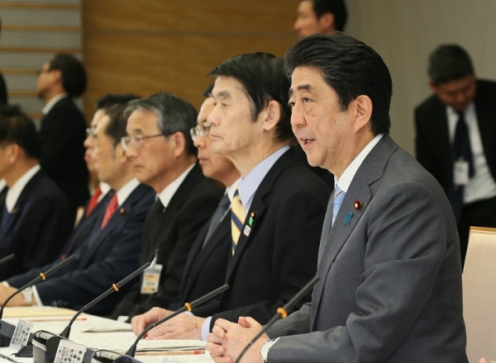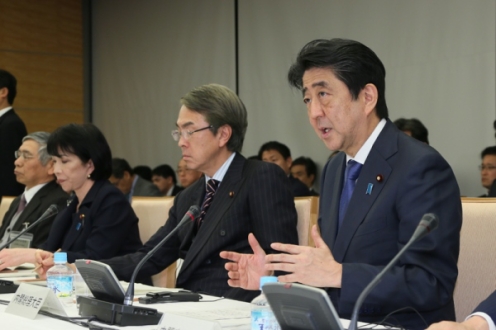Cabinet Secretariat [Saturday, March 11, 2017]
Memorial Ceremony Marking the Sixth Anniversary of the Great East Japan Earthquake
Prime Minister Shinzo Abe attended the Memorial Ceremony Marking the Sixth Anniversary of the Great East Japan Earthquake held in Tokyo in the presence of Their Imperial Highnesses Prince and Princess Akishino.
Following the moment of silence, the Prime Minister delivered an address.
This was followed by the address of His Imperial Highness Prince Akishino. Afterwards, the Speaker of the House of Representatives, the President of the House of Councillors, and the Chief Justice of the Supreme Court gave their memorial addresses. The representatives of the bereaved family members delivered addresses, and then the participants offered flowers.

Cabinet Secretariat [Saturday, March 11, 2017]
Address by the Prime Minister Shinzo Abe to the Memorial Ceremony Marking the Sixth Anniversary of the Great East Japan Earthquake
In the gracious presence of Their Imperial Highnesses Prince and Princess Akishino, it is with the deepest respect that I, representing the Government of Japan, express my condolences on the occasion of the Memorial Ceremony marking the Sixth Anniversary of the Great East Japan Earthquake.
Six years have passed since the Great East Japan Earthquake, which caused unprecedented damage centered on north-east Japan and claimed many precious lives.
When I think of the despair of those who lost beloved members of their families and friends in the disaster, I am overwhelmed even now with deep sorrow. It is with my deepest sympathy that I reiterate my sincerest condolences. I would also like to extend my heartfelt sympathies to all those who have been affected by the disaster.
On each occasion that I visit the affected areas now, six years after the disaster, I feel that reconstruction is steadily making progress. Restoration of infrastructure is nearly complete, while the rebuilding of homes and the revitalization of industries and livelihoods are proceeding step by step.
Furthermore, the lifting of evacuation zones is gradually being implemented in Fukushima, prompting me to feel that reconstruction has reached a new stage. Nevertheless, even today, 120,000 people are still in evacuation, leading uncomfortable lives.
By being aware of the circumstances of each and every one of the affected individuals, we commit ourselves to such tasks as providing care for their minds and bodies, forming new local communities and supporting development that meets the needs of the affected areas, so that reconstruction can be further accelerated.
Consequently, with the determination to always take into consideration the valuable lessons learned from the enormous damage caused by the disaster, we will ceaselessly review disaster-prevention measures and integrate the latest wisdom and knowledge into our defenses. Once again, I would like to make a firm pledge here that the government will exert its united efforts to build a strong and resilient nation that is resistant to disasters.
Since the earthquake disaster, reconstruction has proceeded due to the tremendous support and efforts of the local people and numerous related parties. Warm support and assistance have poured in from every corner of Japan, and also from countries and regions around the world, many of whose representatives are present here today. I would like once again to express our sincere gratitude as well as our respect.
It is our responsibility to share with the rest of the world the lessons of the Great East Japan Earthquake, as well as our disaster prevention knowledge and technology that can be instrumental in minimizing future disasters. We will further strengthen our international contributions in the field of disaster prevention.
In the past, our nation suffered countless disasters that could be described as national crises, but overcame them each time with determination and hope. I vow once again that we will follow hand in hand in the footsteps of our forefathers and continue to move forward.
In concluding, I would like to offer my heartfelt prayers for the eternal repose of the souls of those who lost their lives and I pray for the peace and tranquility of their bereaved family members.
March 11, 2017
Shinzo Abe
Prime Minister of Japan
Cabinet Secretariat [Friday, March 10, 2017]
Joint Meeting of the Reconstruction Promotion Council and the Nuclear Emergency Response Headquarters
[Provisional Translation]
Prime Minister Shinzo Abe jointly held the 18th meeting of the Reconstruction Promotion Council and the 45th meeting of the Nuclear Emergency Response Headquarters at the Prime Minister’s Office.
During the meeting, the dissolution of Evacuation Order Zones in Namie Town and Tomioka Town was decided, and there was discussion on the current situation and issues in the six years of reconstruction, and progress on Fukushima's reconstruction from the nuclear disaster.
Based on the discussion, the Prime Minister said,
“Tomorrow marks a full six years since the Great East Japan Earthquake.
As a result of the focused public investments to date, by spring of next year, in the three most-affected prefectures in Tohoku, we expect to have finished construction of over 95% of public housing for disaster-stricken households, and 90% of the transfer of homes to areas of high elevation. The value of shipments of manufactured goods as well is recovering to the level it was prior to the disaster.
In terms of infrastructure too, it is expected that the JR Joban Line will be fully operational by March 2020, and that 90% of the route between Sendai and Hachinohe on the Sanriku Coast Road will be operational by 2020.
Reconstruction is advancing steadily.
Concerning Fukushima, today we made the decision to dissolve Evacuation Order Zones in Namie Town and Tomioka Town. Excluding Okuma Town and Futaba Town, all areas in which the residents are not permitted to live and areas to which evacuation orders are ready to be lifted will be dissolved this spring. We are entering the full-scale reconstruction stage.
We have submitted a draft bill for the amendment of the Law on Special Measures for the Reconstruction and Revitalization of Fukushima to the Diet toward the future reconstruction and revitalization of Fukushima. I would like relevant ministers to exert every effort for the formulation of draft laws to ensure that people who wish to return to their hometowns can do so at an early date. At the same time, I want relevant ministers to establish a cabinet meeting on the Fukushima Innovation Coast Scheme by the summer, and work towards the realization of the scheme.
The major precondition for advancing reconstruction in Fukushima is ensuring the safety of the Tokyo Electric Power Company (TEPCO) Fukushima Daiichi Nuclear Power Station. I ask that members of the national government stand on the front lines of this issue, and carry out safe and steady decommissioning and water decontamination measures.
There can be no revitalization of Japan without the reconstruction of Tohoku.
We will carry out seamless support for those affected by the disaster, further reconstruction of residences and towns, the rebuilding of livelihoods through tourism promotion and work to dispel reputational damage caused by harmful rumors, reconstruction and revitalization from the nuclear disaster, and, in particular, the fostering of human resources who can support the future of the disaster-affected regions and efforts to improve the emotional well-being of those who experienced the disaster.
All of these efforts are indispensable for the reconstruction of Tohoku.
I again instruct all ministers to share the mindset that they are each Ministers for Reconstruction, and to exert every effort from their respective positions, while paying close attention to the feelings of those affected by the disaster.”

Cabinet Secretariat [Tuesday, March 14, 2017]
Meeting of the Council on Economic and Fiscal Policy
[Provisional Translation]
Prime Minister Shinzo Abe held the third meeting in 2017 of the Council on Economic and Fiscal Policy at the Prime Minister's Office.
At the meeting, there was discussion on the economies of the United States and other countries.
Based on the discussion, the Prime Minister said,
“Today we welcomed Professor Joseph Stiglitz of Columbia University, a recipient of the Nobel Prize in Economic Sciences whom I have met several times and who has advised us on our three arrows of Abenomics policies. He has shared his advice on the state of the global economy and policy issues.
We heard from Professor Stiglitz that a slowing of productivity growth and growing disparities are common issues faced by developed nations, and received the message that it is important that people share the benefits of growth, and that we should address issues such as achieving fairness in income; strengthening the education, health, and nursing care service sectors; and advancing innovation.
I feel that Professor Stiglitz’s views have commonalities with the concepts of the policies that we are now progressing in the second stage of Abenomics. I now have a renewed awareness that the Abe administration must advance measures such as promoting investment in research and development with the background of the fourth industrial revolution, increasing the annual wage rise to 3% and aiming for a minimum wage of 1,000 yen per hour, workstyle reforms such as introducing equal pay for equal work to improve the conditions for those in non-regular employment, maintaining the nursing care and childcare facility environment; and advancing systems and policies so that anyone can receive higher education regardless of any family financial difficulties. Moreover, I am firmly resolved that we must further accelerate these measures.
Finally, I would like to conclude my remarks by expressing my heartfelt thanks to Professor Stiglitz for crossing the ocean to visit Japan and sharing his valuable advice with us.”
